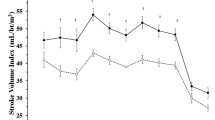Abstract
Purpose
Chronic autonomic failure syndromes such as Parkinson disease with orthostatic hypotension (PD + OH), multiple system atrophy (MSA), and pure autonomic failure (PAF) typically feature arterial baroreflex failure. Identifying baroreflex-sympathoneural failure from hemodynamic responses to the maneuver usually has been qualitative. We report quantitative methods for evaluating baroreflex-sympathoneural function, based on beat-to-beat systolic blood pressure (BPs) responses to the Valsalva maneuver.
Method
Using the trapezoid rule, we calculated the area under the curve (baroreflex area, BRA) between baseline systolic blood pressure (BPs) and the BPs for each beat in Phase II (BRA-II) and Phase IV (BRA-IV) in 136 autonomic failure patients and 171 controls. The sum of the areas was defined as total BRA (BRA-T). We compared individual values by the BRA approach with those by other measures.
Results
Mean values for log BRA-II, BRA-IV, and BRA-T were higher in PD + OH, PAF, and MSA than in controls (p < 0.001 each). The log of BRA-T correlated negatively with the fractional orthostatic change in total peripheral resistance (r = −0.41, p < 0.001), fractional orthostatic change in plasma norepinephrine (r = −0.27, p < 0.001), orthostatic change in BPs (r = −0.62, p < 0.001), fall in BPs in Phase II of the Valsalva (r = 0.58, p < 0.001), and log of baroreflex-cardiovagal slope (r = −0.40, p < 0.001). Areas under receiver operating characteristic curves were 0.85 for BRA-T and 0.89 for BRA-IV (p < 0.001).
Conclusion
The BRA approach provides quantitative measures of baroreflex-sympathoneural function. Chronic autonomic failure syndromes entail deficiencies of both the cardiovagal and sympathoneural limbs of the arterial baroreflex.



Similar content being viewed by others
Abbreviations
- BRS:
-
Baroreflex slope
- BPs:
-
Systolic blood pressure
- BPd:
-
Diastolic blood pressure
- BRA-T:
-
Total baroreflex area
- BRA-II:
-
Baroreflex area in Phase II
- BRA-IV:
-
Baroreflex area in Phase IV
- Fx∆:
-
Fractional change
- HF:
-
High frequency
- HR:
-
Heart rate
- LF:
-
Low frequency
- PD:
-
Parkinson disease
- MSA:
-
Multiple system atrophy
- NE:
-
Norepinephrine
- OH:
-
Orthostatic hypotension
- PAF:
-
Pure autonomic failure
- TPR:
-
Total peripheral resistance
References
Benarroch EE, Schmeichel AM, Parisi JE (2000) Involvement of the ventrolateral medulla in Parkinsonism with autonomic failure. Neurology 54:963–968
Benarroch EE, Schmeichel AM, Sandroni P, Low PA, Parisi JE (2006) Involvement of vagal autonomic nuclei in multiple system atrophy and Lewy body disease. Neurology 66:378–383
Freeman R, Wieling W, Axelrod FB, Benditt DG, Benarroch E, Biaggioni I, Cheshire WP, Chelimsky T, Cortelli P, Gibbons CH, Goldstein DS, Hainsworth R, Hilz MJ, Jacob G, Kaufmann H, Jordan J, Lipsitz LA, Levine BD, Low PA, Mathias C, Raj SR, Robertson D, Sandroni P, Schatz I, Schondorff R, Stewart JM, van Dijk JG (2011) Consensus statement on the definition of orthostatic hypotension, neurally mediated syncope and the postural tachycardia syndrome. Clin Auton Res 21:69–72
Goldstein DS (1983) Arterial baroreflex sensitivity, plasma catecholamines, and pressor responsiveness in essential hypertension. Circulation 68:234–240
Goldstein DS, Holmes C, Bentho O, Sato T, Moak J, Sharabi Y, Imrich R, Conant S, Eldadah BA (2008) Biomarkers to detect central dopamine deficiency and distinguish Parkinson disease from multiple system atrophy. Parkinsonism Relat Disord 14:600–607
Goldstein DS, Horwitz D, Keiser HR (1982) Comparison of techniques for measuring baroreflex sensitivity in man. Circulation 66:432–439
Goldstein DS, Tack C (2000) Non-invasive detection of sympathetic neurocirculatory failure. Clin Auton Res 10:285–291
Holmes C, Eisenhofer G, Goldstein DS (1994) Improved assay for plasma dihydroxyphenylacetic acid and other catechols using high-performance liquid chromatography with electrochemical detection. J Chromatogr B Biomed Appl 653:131–138
Kaufmann H, Oribe E, Miller M, Knott P, Wiltshire-Clement M, Yahr MD (1992) Hypotension-induced vasopressin release distinguishes between pure autonomic failure and multiple system atrophy with autonomic failure. Neurology 42:590–593
Lake CR, Ziegler MG, Kopin IJ (1976) Use of plasma norepinephrine for evaluation of sympathetic neuronal function in man. Life Sci 18:1315–1325
Pickering TG, Sleight P (1969) Quantitative index of baroreflex activity in normal and hypertensive subjects using Valsalva’s manoeuvre. Br Heart J 31:392
Schrezenmaier C, Singer W, Swift NM, Sletten D, Tanabe J, Low PA (2007) Adrenergic and vagal baroreflex sensitivity in autonomic failure. Arch Neurol 64:381–386
Vogel ER, Sandroni P, Low PA (2005) Blood pressure recovery from Valsalva maneuver in patients with autonomic failure. Neurology 65:1533–1537
Ziegler MG, Lake CR, Kopin IJ (1977) The sympathetic-nervous-system defect in primary orthostatic hypotension. N Engl J Med 296:293–297
Acknowledgement
Division of Intramural Research, NINDS, NIH.
Conflict of interest
The authors have no conflicts of interest to disclose.
Author information
Authors and Affiliations
Corresponding author
Electronic supplementary material
Below is the link to the electronic supplementary material.
Rights and permissions
About this article
Cite this article
Rahman, F., Goldstein, D.S. Quantitative indices of baroreflex-sympathoneural function: application to patients with chronic autonomic failure. Clin Auton Res 24, 103–110 (2014). https://doi.org/10.1007/s10286-014-0234-1
Received:
Accepted:
Published:
Issue Date:
DOI: https://doi.org/10.1007/s10286-014-0234-1




